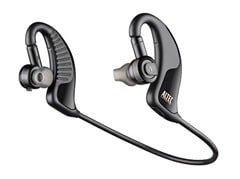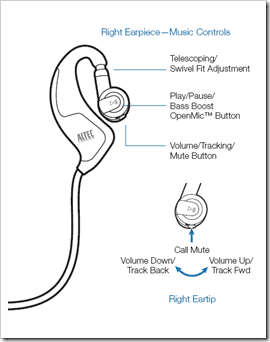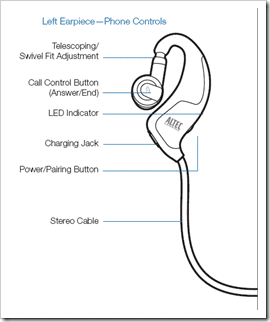I must say, I had been waiting for the iPhone to support A2DP for a while. When it finally rolled out, I was excited but I didn’t have a set of headphones with which to test it. I just hadn’t made the plunge to buy a set. The promise of having stereo audio from my iPhone, all via a Bluetooth connection was stupendous. I was simply tired of untangling my traditional headphones each and every time I took them out of my pocket. And, the ability to just have no cords whatsoever, was great.
The folks at Altec Lansing‘s PR firm really came to my rescue by sending me a pair of BackBeat 903s which, via Bluetooth, handle both my iPhone’s music playback but also phone calls as well, all packaged in a ruggedly designed headset. Below is a quick video review of the BackBeats after which you can see the rest of my review:
If you are looking for a Bluetooth headset and you have ensured that your phone handles A2DP (which stands for Advanced Audio Distribution Profile) and AVRCP (to control the playback with your headphones – Audio/Video Remote Control Profile), then you probably should put the BackBeats on the list of headsets to test out. They are relatively light weight, very functional, produce good balanced sound and are reasonably priced.
Setup
When you first use the BackBeats, you need to pair it with your iPhone (or other Bluetooth-enabled device). Be sure you charge it for about an hour the 1st time (it takes about 2-3 hours for a full charge). The steps for pairing are very simple:
- Enable Bluetooth on your music device or phone.
- Press & Hold the Power/Pairing button (from an off state) until it flashes red and blue.
- Check your phone or music device for the appearance of “9xxBackBeat”. When it is there, select it.
- If you need to enter in a PIN, enter 0000.
- Once you are successfully paired, the LED will simply flash blue.
Adjusting the headset to fit your ears can be done in two ways, first by extending and/or pivoting the earpiece and second rotating the piece that actually fits into your ear. The ear pieces do slip over the top of your ears and rest there (see the video above). The headset cord goes behind your neck.
Usage
It is actually funny that you have to learn how to use the BackBeat controls completely by touch since you can’t see it. You only use two senses with the BackBeats, touch and sound (obviously). The point here is, since you cannot actually see the device, the controls much be easy to figure out and convenient to use, using either tactile or audio feedback. For the most part, they are.
On the Right Earpiece, there is a Play/Pause/Base Boost and OpenMic Button. (I honestly couldn’t understand what the whole “OpenMic” was all about. All that I could figure out was that it would pause the audio so that you could hear your surroundings. No magic there.). The button that does this is right on the front. On the side of the earpiece, there is a Volume/Tracking/Mute button. This is like a little toggle/slider that you move forward or backward (with audio responses, for example, as you raise or lower the volume). Pushing this slider in mutes the call if you are on one.
On the Left Earpiece, there is the Call Answer/End button (on the outside similar to the Play/Pause button of the Right Earpiece), the LED indicator, the charging jack (included is a USB wall charger) and the power/pairing button.
Using just these controls and getting visual (ok, I lied, you do have to look at the BackBeats once and a while) and/or audio feedback, you can do a wide variety of things including:
- Answer/Make/Reject/End a call
- Check battery power
- Mute/Un-mute a call
- Adjust volume
- Play/Pause music
- Move forward/back one track of music
- Answer or Reject a call while listening to music
- Boost the bass
There are some tricks to this so you probably should give the manual a quick read. For the most part, it is easy to control and use, even without looking at the headset.
Quick Specs
To nail down some specs of the BackBeat 903:
- Talk Time – 7 hrs
- Listening time – 7 hrs
- Standby time – 7 hrs
- Range – 33 feet
- Weight – 34 grams
- Charge time – 2-3 hours
- Bluetooth version – 2.1 + EDR (Enhance Data Rate)
- Bluetooth profiles – HSP, HFP, Secure Simple Pairing, A2DP and AVRCP
My Commentary
In my opinion, I have yet to come across ANY device that is perfect. While this headset was indeed given to me, I need to ensure that both its positives and negatives are discussed. To that end:
- I feel that the standby time is a lot less than desired. It seems that the power is draining the battery no different connected and streaming music than if it was simply on and sitting in your pocket doing nothing.
- If you do have a chance to test them out, DO IT! They might not be a clean fit with your ear.
- I found the BackBeats to be comfortable for shorter use times (less than an hour). Anything more than an hour started to be a bit uncomfortable and my ears felt a bit pinched at times. Headsets should be comfortable for extended times, in my opinion.
- My kids commented that they could hear my music or spoken audio from a distance. Note that these are not completely sound isolating, in-ear headphones. Some sound does bleed in and out of your ears.
- Until you get used to it, putting the BackBeats on is a bit of a challenge (see the video). Be prepared to look a bit dorky in the process of learning.
- I have sort of a love/hate relationship with the flexible cord between the two ear pieces. I think its great to be able to roll it all up and put in my pocket, but sometimes it gets a bit twisted and makes putting on your head a bit confusing.
- The sound quality is pretty good. If you do use too much bass (using the Bass Booster), you can quickly run into some music distortion, especially at higher volumes. The quality is decent, however I get better sound performance from my corded Sennheisers.
- I did encounter some popping and clicking at times where I would lose audio for about a second or two. While this was annoying, it did not happen very frequently. Most of the time it occurred when I was mobile, and with no apparent interference sources immediately around me.
- Once paired, the BackBeats connect fairly quickly to my iPhone which was nice.
Overall, if you are a bit tired of the 1 ear Bluetooth headset (I know that I am!) and want to explore the possibilities of stereo Bluetooth audio, you definitely should take a look at the BackBeat 903s. The parent company is Plantronics who are experts in voice technology and have been for many years. The BackBeat 903’s MSRP is $99.95 but you can pick a pair up on Amazon for $59.99.
So for the same price as a single ear, higher-end Bluetooth earpiece, you could be enjoying stereo Bluetooth music playback and phone control, complete with Plantronics dual-mic AudioIQ® voice technology. The sound is fairly good and I have not received complaints from anyone receiving my calls (unless they simply didn’t want to hear from me – grin).
HTD says: Bluetooth stereo headsets are the way to go nowadays. The BackBeat 903s help you wirelessly bring that beat from your Bluetooth phone or music player to your ears.






19 comments
Dave
Are there any problems with comfort for those who wear glasses?
badcrusher10
Since you haven't used them in a while. Can I have them? lol
hightechdad
I haven't used my BackBeats in a while but I will try to answer from memory:
1) You probably don't have enough time to do what you are suggesting. In fact, I would think that most BT headsets can't do that. I believe you can easily answer the call on the phone, turn on your BT headset and simply switch the audio source
2) Yes, practice makes perfect!
3) Agree with that
4) That's right, it controls iTunes pretty well
I'm trying to remember the toggle, I think for volume you press and hold to change the volume whereas the track skip is by quickly clicking.
Thanks for the comment!
Shu
Great blog. I was actually looking for more of a how-to guide. Here are some questions and some pointers:
Pointers:
1. Consider how fast it pairs. if your phone is ringing, you can turn it on, hear it pair, and then answer the call all before it goes to voicemail. That takes care of the standby time issue.
2. When putting them on, put the shiny end up and the bottom of the U away from yourself. Get used to it, and you're good to go.
3. Use the pause button to listen to conversations around you, not the volume toggle.
4. Whether you're listening to itunes or it's even on, you can hit the pause button and it will kick on the latest song you were listening to!
Question:
The volume up and down toggle and the skip track is the same button. How do you differentiate? All I've ever done is change the volume -what I'd really like to do is skip tracks when using (not so) genius playlist creator while on a jog… I don't to pull it out, wake it up, and skip tracks while running.
(love this device)
shu
hightechdad
I only had a little bit of drop out sometimes when walking. I don't have the version with the BT adapter. I haven't played with the Jaybird but I will look to see if I can. Thanks!
bentheman
Thanks for this review. I have read about problems with the BT range of this headset, where it's supposed to connect badly if the audio source (specifically an ipod, using the BT adapter that comes packaged with the AL 903) sits in your pockets. Have you had any similar experiences?
And another question, maybe you can get your hands on the Jaybird jb-200 an compare the two? It seems to be a very close match between the 2.
burrzoo
dup…ignore
JBert
This issue of not being able to completely lower the volume on the 903s seems to be a Design Flaw as others have mentioned the same problem in discussion boards or reviews. The 903s are great in a noisier environment but when I am in a quiet setting I too am unable to lower the volume to a comfortable level of sound. Too bad that the iPhone's volume is disabled when any BT device is connected (unlike my old Treo 600 or HTC TyTn II (WinMo OS) or we wouldn't have to worry about this. I have the Lubix NC1's but prefer to wear the 903s. Altec Lansing doesn't seem to want to acknowledge that this problem exists and just keeps suggesting that I return them for a replacement. I don't want to waste my time or money to ship them out only to get another pair that has the same flaw. I issued another trouble ticket to see if they have come up with any new answers yet.
burrzoo
dup…ignore
JBert
This issue of not being able to completely lower the volume on the 903s seems to be a Design Flaw as others have mentioned the same problem in discussion boards or reviews. The 903s are great in a noisier environment but when I am in a quiet setting I too am unable to lower the volume to a comfortable level of sound. Too bad that the iPhone's volume is disabled when any BT device is connected (unlike my old Treo 600 or HTC TyTn II (WinMo OS) or we wouldn't have to worry about this. I have the Lubix NC1's but prefer to wear the 903s. Altec Lansing doesn't seem to want to acknowledge that this problem exists and just keeps suggesting that I return them for a replacement. I don't want to waste my time or money to ship them out only to get another pair that has the same flaw. I issued another trouble ticket to see if they have come up with any new answers yet.
hightechdad
That is actually very common. You may be able to play or pause, but
not skip or rewind songs on the iPhone. The is specific to iPhones
only though. It's not working incorrectly, just not fully implemented
by Apple.
winters
Can't seem to use the music controls on the headset for my iphone….how about you
BearPaw
Thanks for the info.
hightechdad
You aren't alone with the comfort level. As I mentioned in the review,
the BackBeats are good for about an hour. However, I have found myself
going back to using my Sennheiser MM 50 iP headphones because I do
actually like the sound quality and the outside noise dampening: https://www.hightechdad.com/2009/06/18/sennheise…
BearPaw
I think my biggest issue is with ear buds in general. I don't know if I just have weird-shaped ears or what, but I can't keep buds in my ears for more than about 20 minutes. And that's if I'm sitting still — if I'm moving around, forget it. I've tried 5 or 6 different buds, extra covers designed to help them fit more snugly, none of them worked very well. And the Lubix headset was no better or worse than others. That's why I got the 903, because I wanted something supported by the ear itself and not just the fit of the bud.
hightechdad
Thanks for the update. I may have to look for the Lubix. I took a
quick look at the NC1's. Interesting form factor. They look a bit
awkward, are they comfortable?
BearPaw
I find I'm not able to get them to go as low as I would like. I have a Lubix BT headset, and it will go low enough that it does not overpower outside sounds. I like to listen to music at work, but I still have to be able to hear pages over my desk set phone's speaker. With Lubix it's no problem, but with the 903, even at the lowest setting, it's just too loud.
hightechdad
Yes, I still have them. That is one of the unfortunate thing about
Bluetooth audio connected headphones, you can't control the volume
using your iPhone or BT connected device. You are essentially at the
mercy of the headset to control the volume. You can step through the
various volume levels, but I too didn't find it as gradual as with the
iPhone. In my tests, you can get the BackBeats pretty low, using the
little volume toggle on the side. Are you experiencing something
different?
BearPaw
I agree with most everything you say about the 903. And if you still use them, I have a question. Sometimes want to turn my music volume down low to be able to hear outside sounds. But the volume on the 903 won't go down as low as I would like. Have you experienced anything similar?
Thanks